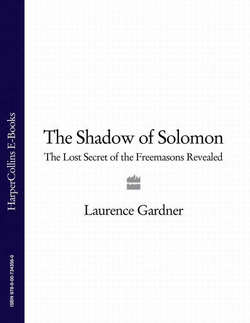Читать книгу The Shadow of Solomon: The Lost Secret of the Freemasons Revealed - Laurence Gardner - Страница 28
The New Foundation
ОглавлениеFollowing the death of Sir Christopher Wren in 1723, those at the forefront of Hanoverian Freemasonry began to formulate an historical backdrop for their evolving, non-operative Craft. Such things as tolerance and benevolence were cemented as objectives, while signs and tokens were established, along with the aim of building a socially aware community. There was little similarity between this and the more scientific or architecturally based movements whose format they endeavoured to emulate, but a convenient biblical metaphor was to hand—the building of Solomon’s Temple. By way of allegory and symbolism, the methods of the Hiramic masons of Jerusalem could be used as emblematic models for building an exemplary Craft culture—and within such a framework it was logical enough to adopt the guise of a stonemasons’ guild. That apart, there does appear to have been some friction at the outset between the premier Grand Lodge and the operative trade guilds with which they sought alignment, but this was soon overcome.8 This seems to have been effected by enticing high-ranking nobility into the fold, with John, 2nd Duke of Montagu accepting the Grand Mastership in 1721, followed by Philip, Duke of Wharton on 17 January 1723.
Only from that date were any Minutes kept of the meetings. Anderson’s first Constitutions were officially sanctioned, and it was determined that new lodges could only be considered ‘Regular ‘ (legitimate) if they were constituted by the Grand Master or an appointed deputy. So, in spite of the initial socially-minded objectives, the first real moves in the process of establishing an institute of fraternal ‘equality’ were actually the denial of freedom in the field, and the creation of a dictatorial hierarchy! In parallel, much the same was happening within the confines of the Royal Society as it became more bureaucratic and exacting in the Georgian style.
Although installed as King of Britain in 1714, George I openly mistrusted the English since they had already rid themselves of two kings in the previous 65 years, and had executed the Queen of Scots prior to that. He preferred to rely on his German ministers and, since he could not speak a word of English, George ran his kingly affairs from Hanover with his prime minister Robert Walpole holding the reins at Westminster from 1721.
George II succeeded his father in 1727, only to display a similar lack of empathy with the populace. Ten years later, however, King George’s eldest son Frederick, Prince of Wales, was initiated into Freemasonry at Kew, and Grand Lodge thereby gained its first royal member.9 His membership was of little consequence though—and in opposition to his father, Frederick joined the Stuart cause after the 1745 Jacobite Rising of Bonnie Prince Charlie. During the course of this civil war and the simultaneous War of Austrian Succession (1740-48), there was very little lodge activity recorded, and it is claimed that, because of these campaigns, English Freemasonry fell into a severe decline. That is the official story—in practice quite the reverse was the case; the lodges were never so lively as they were during that era.
